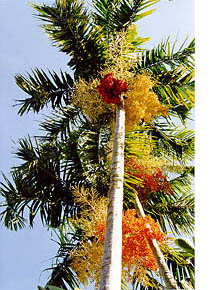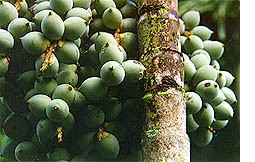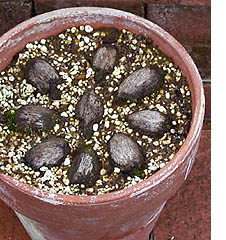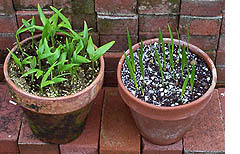Palm Seed Germination
By Ken Neugent
Nursery Manager

We've all seen palms loaded with seeds, ranging in size from those of the amazing double coconut (Lodoicea maldivica), the largest seeds of the plant kingdom to tiny grains just a few millimeters across, like those of the lady palm (Rhapis excelsa). Their shape can be round, oval, or even irregular. The sight of all these seeds with their tempting potential may have led you to think about trying to germinate them.
The method we use to sprout our palm seeds at the Garden's nursery has proved itself over time, and you may enjoy trying it. Whatever species you choose, you should start with fresh seed. Seed should be collected as soon as it is ripe, when the fruit is showing some color or has fallen freshly from the tree. The number of seeds you collect is not as an important factor as the freshness, as freshness will almost guarantee good results.

Palm seeds develop within some form of fleshy fruit which needs to he removed from the seed before you attempt to plant it. In nature this cleaning is done when the fruit is eaten and passes through the gut of a bird or animal. The removal of the fleshy part of the fruit increases your odds of good results by eliminating the chance of fungus growth and subsequent contamination of the seeds.
In some species the fleshy fruit can simply be rubbed away from the seed under running water. In others, however, a knife will be needed to gently separate the fruit from the seed. Be careful to avoid damaging the seed coat that protects the interior of the seed. You don't want to provide a way for insects or fungus to enter your seed.
Caution should be used in cleaning seeds as some contain an irritant that may aggravate your skin. You may want to wear rubber gloves when cleaning fishtail palms (Caryota), royal palms (Roystonea), and Chamaedorea.
Palm seeds tend to have a short term viability after maturing, especially if any type of drying is involved. At the nursery, we soak seeds in water for 24 hours after we receive them. Dried seeds germinate erratically or not at all. To test your seed for viability you can perform the float test. Good quality seeds tend to sink in water, while seeds which are not fully developed or are pest-infected will float. Mind you, this is only a test, as some seeds float as a means of dispersal. But if some seeds float while others of the same species sink, the floaters are likely to be infertile.
After soaking, we treat the seeds with a 10% solution of bleach (one part bleach to ten parts water). We dip the seeds into the solution to disinfect them and then rinse thoroughly.
The endosperm, which is the major portion of a palm seed, contains the necessary food tissue for the young seedling. Within the endosperm is the plant embryo itself. If the seed is allowed to dry, the endosperm may shrivel and lose contact with the seed coat. This prevents the embryo from absorbing any water through the seed coat from the soil.

At the nursery a "community pot" method is used, planting many of the same species in each pot. We use common clay pots with enough depth to allow for proper root development. The seeds are spaced far enough apart to allow for future growth.
The soil used is our "nursery mix" but any good soil mix that is well drained with moisture-holding ability is fine. Your goal is a happy medium – dampness is vital for seed germination, but overly wet soil leads to rotting, and allowing seeds to dry out is a disaster.
How deep to sow the seeds is open for debate. At the nursery we plant our seeds rather shallowly, often with the top of the seeds exposed above the soil. Do use enough soil to prevent the seeds from drying out.
Palm seeds require high temperatures, usually 70° to 100° F. to properly germinate. We have these kind of temperatures during summer here in South Florida, but if you collect your seed in any other season, some way must be found to keep them warm when planted. One method is to use some form of bottom heat.
The amount of light is not a factor in germination. Any shady location will do, as long as the requirements of temperature and moisture can be maintained. The temptation to locate your seeds in the sun should be avoided. While this will give you the needed high temperatures, drying out will be inevitable. Remember, seeds which fall from the parent tree in nature normally germinate in shady locations.

Palms are well-known for their erratic behavior in germinating. Some take weeks to show any sign of sprouting. Different species will give different results. But follow the guidelines above, be patient, and the sequence of cues generated internally from the embryo and externally from the seed environment will result–eventually–in a majestic palm.